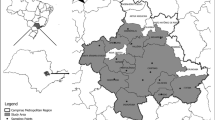Abstract
N-nitrosodimethylamine (NDMA) and several other N-nitrosamines have been detected as disinfection by-products in drinking waters in many countries around the world. An ultra-performance liquid chromatographytandem mass spectrometry method with solid phase extraction sample preparation was developed to study the occurrence of N-nitrosamines in several water treatment plants and distribution systems in China. Isotope labeled N-nitrosodi-n-propylamine-d14 (NDPA-d14) was selected as the internal standard for quantification. The solid phase extraction procedures including pH, enrichment process and MS/MS parameters including capillary voltage, cone gas flow, cone voltage, collision energy were optimized to give average recoveries of 26% to 112% for nine N-nitrosamine species. The instrument detection limits were estimated to range from 0.5 to 5 μg·L−1 for the nine N-nitrosamine species. NDMA and several other N-nitrosamines were found at fairly high concentrations in several water treatment plants and distribution systems. NDMA was found in all locations, and the highest concentrations in cities B, G, T, and W were 3.0, 35.7, 21.3, and 19.7 ng·L−1, respectively. A wide range of N-nitrosamines concentrations and species were observed in different locations. Higher concentrations of N-nitrosamines were detected in distribution systems that were further away from the treatment plants, suggesting that the contact time between the residual disinfectant and natural organic matter may play an important role in the formation of these compounds.
Similar content being viewed by others
References
Beller T A, Lichtenberg J J, Kroner R C. Occurrence of organohalides in chlorinated drinking waters. Journal-American Water Works Association, 1974, 66 (12): 703–706
Rook J J. Chlorination reactions of fulvic acids in natural waters. Environmental Science & Technology, 1977, 11(5): 478–482
Richardson S D. Disinfection by-products and other emerging contaminants in drinking water. TrAC Trends in Analytical Chemistry, 2003, 22(10): 666–684
Zhao Y Y, Boyd J, Hrudey S E, Li X F. Characterization of new nitrosamines in drinking water using liquid chromatography tandem mass spectrometry. Environmental Science & Technology, 2006, 40 (24): 7636–7641
US Environmental Protection Agency. The Occurrence of Disinfection By-Products (DBPs) of Health Concern in Drinking Water: Results of a Nationwide DBP Occurrence Study. EPA/600/R02/068. Athens, GA: National Exposure Research Laboratory, 2002
Plewa M J, Wagner E D, Richardson S D, Thruston A D Jr, Woo Y T, McKague A B. Chemical and biological characterization of newly discovered iodoacid drinking water disinfection byproducts. Environmental Science & Technology, 2004, 38(18): 4713–4722
Plewa M J, Wagner E D, Jazwierska P, Richardson S D, Chen P H, McKague A B. Halonitromethane drinking water disinfection byproducts: chemical characterization and mammalian cell cytotoxicity and genotoxicity. Environmental Science & Technology, 2004, 38(1): 62–68
Charrois J W A, Boyd J M, Froese K L, Hrudey S E. Occurrence of N-nitrosamines in Alberta public drinking water distribution systems. Journal of Environmental Engineering and Science, 2007, 6(1): 103–114
Barrett S, Hwang C, Guo Y, Andrews S A, Valentine R. Occurrence of NDMA in drinking water: a North American survey, 2001–2002. In: Proceeding of the American Water Works Association’s Annual Conference. America Water Works Association, Denver CO, USA, 2003: 19
US Environmental Protection Agency. N-nitrosodimethylamine CASRN 62-75-9, Intergrated Risk Information Service (IRIS) Substance File. Washington DC, USA, 1997
US Environmental Protection Agency. Unregulated Contaminant Monitoring Rule 2. Washington DC: US Environmental Protection Agency, 2006
Najim I, Trussell R R. NDMA formation in water and wastewater. Journal-American Water Works Association, 2001, 93(2): 92–99
Planas C, Palacios O, Ventura F, Rivera J, Caixach J. Analysis of nitrosamines in water by automated SPE and isotope dilution GC/HRMS: occurrence in the different steps of a drinking water treatment plant, and in chlorinated samples from a reservoir and a sewage treatment plant effluent. Talanta, 2008, 76(4): 906–913
Jenkins S W D, Koester C J, Taguchi V Y, Wang D T, Palmentier J P F P, Hiong K P. N-nitrosodimethylamine in drinking water using a rapid, solid-phase extraction method. Environmental Science and Pollution Research International, 1995, 2(4): 207–210
Raksit A, Johri S. Determination of N-nitrosodimethylamine in environmental aqueous samples by isotope-dilution GC/MS-SIM. Journal of AOAC International, 2001, 84(5): 1413–1419
Charrois J W A, Arend M W, Froese K L, Hrudey S E. Detecting Nnitrosamines in drinking water at nanogram per liter levels using ammonia positive chemical ionization. Environmental Science & Technology, 2004, 38(18): 4835–4841
US Environmental Protection Agency. EPA/600/R-05/054. Determination of Nitrosamines in Drinking Water by Solid Phase Extraction and Capillary Column Gas Chromatography with Large Volume Injection and Chemical Ionization Tandem Mass Spectrometry (MS/MS). Washington DC, USA, 2004
Plumlee M H, López-Mesas M, Heidlberger A, Ishida K P, Reinhard M. N-nitrosodimethylamine (NDMA) removal by reverse osmosis and UV treatment and analysis via LC-MS/MS. Water Research, 2008, 42(1–2): 347–355
Asami M, Oya M, Kosaka K. A nationwide survey of NDMA in raw and drinking water in Japan. The Science of the Total Environment, 2009, 407(11): 3540–3545
Chen B Y, Westerhoff P. Predicting disinfection by-product formation potential in water. Water Research, 2010, 44(13): 3755–3762
Chen Z, Valentine R L. Formation of N-nitrosodimethylamine (NDMA) from humic substances in natural water. Environmental Science & Technology, 2007, 41(17): 6059–6065
Author information
Authors and Affiliations
Corresponding author
Rights and permissions
About this article
Cite this article
Wang, C., Zhang, X., Wang, J. et al. Detecting N-nitrosamines in water treatment plants and distribution systems in China using ultra-performance liquid chromatography-tandem mass spectrometry. Front. Environ. Sci. Eng. 6, 770–777 (2012). https://doi.org/10.1007/s11783-012-0412-0
Received:
Accepted:
Published:
Issue Date:
DOI: https://doi.org/10.1007/s11783-012-0412-0




